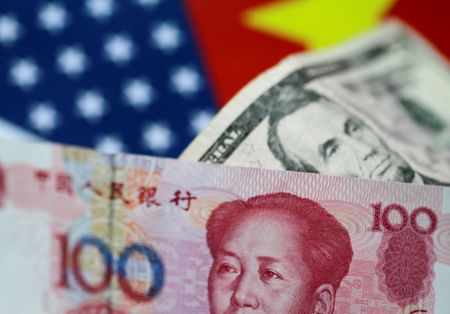Forex
Asia FX surges, dollar sinks on Fed’s rate cut signals


© Reuters.
Investing.com– Most Asian currencies rose sharply on Thursday, while the dollar tumbled from two-week highs after comments from the Federal Reserve kept expectations of interest rate cuts largely in play.
The Fed on Wednesday and maintained its forecast for a 75 basis point reduction in rates this year. The move, particularly the Fed’s outlook, ramped up appetite for high-yielding, risk-driven assets.
Hawkish signals from some Asian economies also boosted regional currency markets.
USDJPY falls from four-month high on Fed signals, BOJ rate hike
The Japanese yen strengthened sharply on Thursday, with the pair falling 0.5% from a four-month high to 150.53.
The prospect of U.S. interest rate cuts and a more hawkish Bank of Japan bode well for the yen, which was battered by rising U.S. interest rates over the past year.
Purchasing managers index data for March showed some resilience in the Japanese economy, with shrinking less than expected, while the grew further.
The BOJ for the first time in 17 years this week, citing some confidence in the Japanese economy. Analysts said that any more monetary tightening by the central bank will be largely driven by the path of Japan’s economy.
AUDUSD surges on red-hot labor data
The Australian dollar was the best performer in Asia on Thursday, with the pair surging 0.6%.
Gains in the Aussie were fueled chiefly by a substantially stronger-than-expected reading on the , which also showed falling to a six-month low.
Labor market strength gives the Reserve Bank of Australia more headroom to keep interest rates higher for longer. This notion helped Aussie bulls to look past less hawkish signaling from the RBA at a meeting earlier this week.
Dollar slides as Fed rate cut bets grow
The and fell sharply in Asian trade on Thursday, amid growing bets that the Fed will begin cutting rates by as soon as June.
Fed officials said the bank was still considering at least a 75 bps cut in rates this year, while Fed Chair Jerome Powell also expressed some confidence in inflation remaining on a path towards the central bank’s 2% annual target.
Traders were now pricing in an over 70% chance the Fed will cut rates by 25 bps in June, according to the .
Broader Asian currencies strengthened on this notion.
The South Korean won’s pair slid 0.3%, while the Singapore dollar’s fell 0.2%.
The Indian rupee’s pair was flat at around 83.07, while the Chinese yuan’s also tread water around 7.1986.
Sentiment towards the yuan was dented by top People’s Bank of China officials signaling that they had enough headroom to enact more rate cuts this year.

 Forex3 years ago
Forex3 years agoForex Today: the dollar is gaining strength amid gloomy sentiment at the start of the Fed’s week

 Forex3 years ago
Forex3 years agoUnbiased review of Pocket Option broker

 Forex3 years ago
Forex3 years agoDollar to pound sterling exchange rate today: Pound plummeted to its lowest since 1985

 Forex3 years ago
Forex3 years agoHow is the Australian dollar doing today?

 Cryptocurrency3 years ago
Cryptocurrency3 years agoWhat happened in the crypto market – current events today

 World3 years ago
World3 years agoWhy are modern video games an art form?

 Commodities3 years ago
Commodities3 years agoCopper continues to fall in price on expectations of lower demand in China

 Economy3 years ago
Economy3 years agoCrude oil tankers double in price due to EU anti-Russian sanctions





















